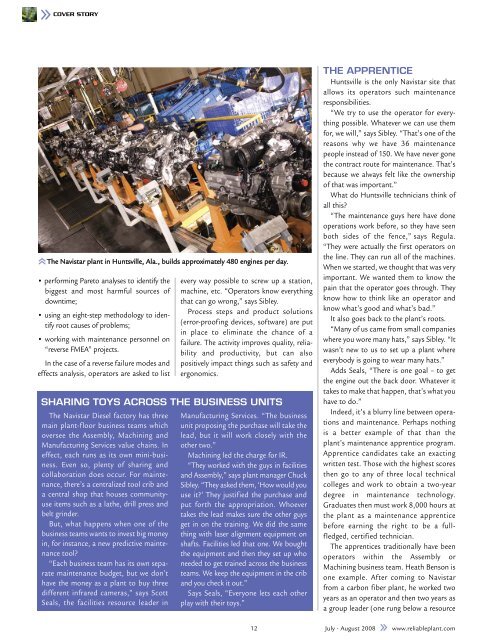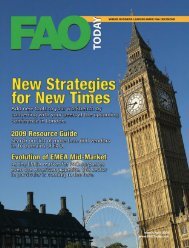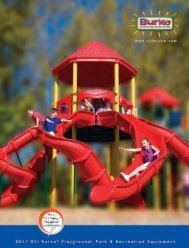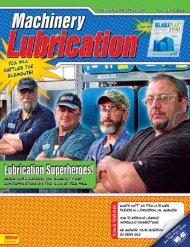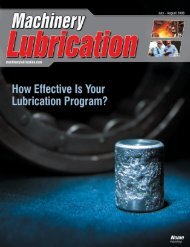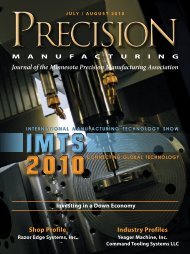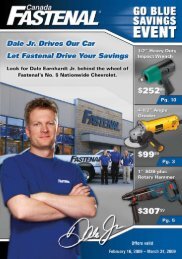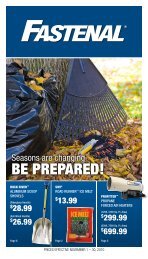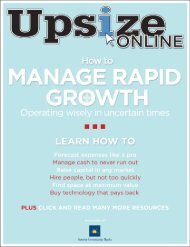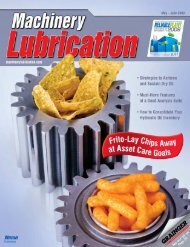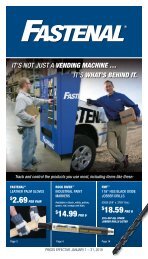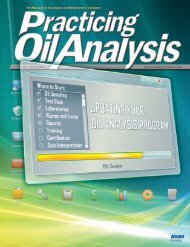Reliable Plant July August 2008
Reliable Plant July August 2008
Reliable Plant July August 2008
Create successful ePaper yourself
Turn your PDF publications into a flip-book with our unique Google optimized e-Paper software.
COVER STORY<br />
The Navistar plant in Huntsville, Ala., builds approximately 480 engines per day.<br />
• performing Pareto analyses to identify the<br />
biggest and most harmful sources of<br />
downtime;<br />
• using an eight-step methodology to identify<br />
root causes of problems;<br />
• working with maintenance personnel on<br />
“reverse FMEA” projects.<br />
In the case of a reverse failure modes and<br />
effects analysis, operators are asked to list<br />
every way possible to screw up a station,<br />
machine, etc. “Operators know everything<br />
that can go wrong,” says Sibley.<br />
Process steps and product solutions<br />
(error-proofing devices, software) are put<br />
in place to eliminate the chance of a<br />
failure. The activity improves quality, reliability<br />
and productivity, but can also<br />
positively impact things such as safety and<br />
ergonomics.<br />
SHARING TOYS ACROSS THE BUSINESS UNITS<br />
The Navistar Diesel factory has three<br />
main plant-floor business teams which<br />
oversee the Assembly, Machining and<br />
Manufacturing Services value chains. In<br />
effect, each runs as its own mini-business.<br />
Even so, plenty of sharing and<br />
collaboration does occur. For maintenance,<br />
there’s a centralized tool crib and<br />
a central shop that houses communityuse<br />
items such as a lathe, drill press and<br />
belt grinder.<br />
But, what happens when one of the<br />
business teams wants to invest big money<br />
in, for instance, a new predictive maintenance<br />
tool?<br />
“Each business team has its own separate<br />
maintenance budget, but we don’t<br />
have the money as a plant to buy three<br />
different infrared cameras,” says Scott<br />
Seals, the facilities resource leader in<br />
Manufacturing Services. “The business<br />
unit proposing the purchase will take the<br />
lead, but it will work closely with the<br />
other two.”<br />
Machining led the charge for IR.<br />
“They worked with the guys in facilities<br />
and Assembly,” says plant manager Chuck<br />
Sibley. “They asked them, ‘How would you<br />
use it?’ They justified the purchase and<br />
put forth the appropriation. Whoever<br />
takes the lead makes sure the other guys<br />
get in on the training. We did the same<br />
thing with laser alignment equipment on<br />
shafts. Facilities led that one. We bought<br />
the equipment and then they set up who<br />
needed to get trained across the business<br />
teams. We keep the equipment in the crib<br />
and you check it out.”<br />
Says Seals, “Everyone lets each other<br />
play with their toys.”<br />
THE APPRENTICE<br />
Huntsville is the only Navistar site that<br />
allows its operators such maintenance<br />
responsibilities.<br />
“We try to use the operator for everything<br />
possible. Whatever we can use them<br />
for, we will,” says Sibley. “That’s one of the<br />
reasons why we have 36 maintenance<br />
people instead of 150. We have never gone<br />
the contract route for maintenance. That’s<br />
because we always felt like the ownership<br />
of that was important.”<br />
What do Huntsville technicians think of<br />
all this?<br />
“The maintenance guys here have done<br />
operations work before, so they have seen<br />
both sides of the fence,” says Regula.<br />
“They were actually the first operators on<br />
the line. They can run all of the machines.<br />
When we started, we thought that was very<br />
important. We wanted them to know the<br />
pain that the operator goes through. They<br />
know how to think like an operator and<br />
know what’s good and what’s bad.”<br />
It also goes back to the plant’s roots.<br />
“Many of us came from small companies<br />
where you wore many hats,” says Sibley. “It<br />
wasn’t new to us to set up a plant where<br />
everybody is going to wear many hats.”<br />
Adds Seals, “There is one goal – to get<br />
the engine out the back door. Whatever it<br />
takes to make that happen, that’s what you<br />
have to do.”<br />
Indeed, it’s a blurry line between operations<br />
and maintenance. Perhaps nothing<br />
is a better example of that than the<br />
plant’s maintenance apprentice program.<br />
Apprentice candidates take an exacting<br />
written test. Those with the highest scores<br />
then go to any of three local technical<br />
colleges and work to obtain a two-year<br />
degree in maintenance technology.<br />
Graduates then must work 8,000 hours at<br />
the plant as a maintenance apprentice<br />
before earning the right to be a fullfledged,<br />
certified technician.<br />
The apprentices traditionally have been<br />
operators within the Assembly or<br />
Machining business team. Heath Benson is<br />
one example. After coming to Navistar<br />
from a carbon fiber plant, he worked two<br />
years as an operator and then two years as<br />
a group leader (one rung below a resource<br />
12 <strong>July</strong> - <strong>August</strong> <strong>2008</strong> www.reliableplant.com


